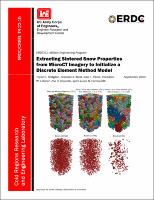Please use this identifier to cite or link to this item:
https://hdl.handle.net/11681/45305Full metadata record
| DC Field | Value | Language |
|---|---|---|
| dc.contributor.author | Hodgdon, Taylor S. | - |
| dc.contributor.author | West, Brendan A. | - |
| dc.contributor.author | Parno, Julie T. | - |
| dc.contributor.author | Letcher, Theodore W. | - |
| dc.contributor.author | Courville, Zoe R. | - |
| dc.contributor.author | Farnsworth, Lauren B. | - |
| dc.creator | Cold Regions Research and Engineering Laboratory (U.S.) | - |
| dc.date.accessioned | 2022-09-07T13:48:04Z | - |
| dc.date.available | 2022-09-07T13:48:04Z | - |
| dc.date.issued | 2022-09 | - |
| dc.identifier.govdoc | ERDC/CRREL TR-22-15 | - |
| dc.identifier.uri | https://hdl.handle.net/11681/45305 | - |
| dc.identifier.uri | http://dx.doi.org/10.21079/11681/45305 | - |
| dc.description | Technical Report | en_US |
| dc.description.abstract | Modeling snow’s mechanical behavior is important for many cold regions engineering problems. Because snow’s microstructure plays a significant role in its mechanical response, it is imperative to initialize models with accurate bond characteristics and realistic snow-grain geometries to precisely capture the microstructure interactions. Previous studies have processed microcomputed tomography scans of snow samples with a watershed method to extract grain geometries. This approach relies on identification of seed points to segment each grain. Our new methodology, called the “moving window method,” does not require prior knowledge of the snow-grain-size distribution to identify seed points. We use the interconnectivity of the segmented grains to identify bond characteristics. We compare the resultant grain-size and bond-size distributions to the known grain sizes of the laboratory-made snow samples. The grain-size distributions from the moving window method closely match the known grain sizes, while both results from the traditional method produce grains that are too large. We propose that the bond net-work identified using the traditional method underestimates the number of bonds and overestimates bond radii. Our method allows us to segment realistic snow grains and their associated bonds, without prior knowledge of the samples, from which we can initialize numerical models of the snow. | en_US |
| dc.description.sponsorship | United States. Army. Corps of Engineers. | en_US |
| dc.description.tableofcontents | Abstract .................................................................................................................................... ii Figures and Tables .................................................................................................................. iv Preface ...................................................................................................................................... v 1 Introduction ...................................................................................................................... 1 1.1 Background ......................................................................................................... 1 1.2 Objectives ............................................................................................................ 5 1.3 Approach ............................................................................................................. 5 2 Laboratory Methodology ................................................................................................. 6 2.1 Snow-sample preparation .................................................................................. 6 2.2 MicroCT imaging ................................................................................................. 7 3 Processing MicroCT Imagery.......................................................................................... 9 3.1 Moving window seed-point identification .......................................................... 9 3.2 Sintered-bond characterization ........................................................................ 10 3.3 Meshing process .............................................................................................. 12 4 Results ............................................................................................................................. 14 5 Conclusions .................................................................................................................... 19 References ............................................................................................................................. 20 Report Documentation Page (SF 298) ............................................................................... 24 | - |
| dc.format.extent | 32 pages / 1.81 MB | - |
| dc.format.medium | - | |
| dc.language.iso | en_US | en_US |
| dc.publisher | Engineer Research and Development Center (U.S.) | en_US |
| dc.relation.ispartofseries | Technical Report (Engineer Research and Development Center (U.S.)) ; no. ERDC/CRREL TR-22-15 | - |
| dc.rights | Approved for Public Release; Distribution is Unlimited | - |
| dc.source | This Digital Resource was created in Microsoft Word and Adobe Acrobat | - |
| dc.subject | Discrete element method | en_US |
| dc.subject | Microcomputed tomography | en_US |
| dc.subject | Microstructure | en_US |
| dc.subject | Snow | en_US |
| dc.subject | Snow mechanics | en_US |
| dc.title | Extracting sintered snow properties from microCT imagery to initialize a discrete element method model | en_US |
| dc.type | Report | en_US |
| Appears in Collections: | Technical Report | |
Files in This Item:
| File | Description | Size | Format | |
|---|---|---|---|---|
| ERDC-CRREL TR-22-15.pdf | 1.81 MB | Adobe PDF |  View/Open |